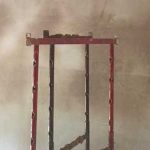In this article, we will be looking at how long blue grit takes to dry. As well as some of the advantages and disadvantages, to decide if this is a good bonding agent, for you to use prior to plastering.
So firstly what is blue grit?
Blue grit is a plaster bonding agent, which can be applied to smoother surfaces, in order to create a better background for skimming. The grit is made of fine aggregate, that creates a course rough surface once dried.

The product is also good at reducing suction on more porous surfaces, and because it sets hard, it also provides a consistent surface across different backgrounds. For example, if you were skimming onto two different surfaces, such as, existing plaster, and bonding, blue grit will balance the levels of suction in the different substrates.
Blue grit is applied with either a paint brush or a short pile roller. It is quite thick, so not the easiest product to work with. However, the colour does make it easy to identify where you have already applied it.
Once applied, Blue Grit takes roughly 24 hours to completely dry. The manufacturer states that it should not be used in temperatures under 5°c, as this will stop it from drying correctly.
Also, in general at lower temperatures the drying time may be extended.
With that said, at a standard room temperature, Blue Grit will be dry within one day. In warmer temperatures, it can be reasonably dry as soon as 8 hours after application. However, even in this situation, it is still advised to wait a full 24hr. This will allow it to achieve maximum adhesion to the sub surface.
You can read plenty of user reviews for Blue Grit on Amazon by clicking here
Disadvantages of blue grit
- The first disadvantage that many people mention, is actually the drying time. The most common alternative to blue grit would be PVA bonding, and this can usually be applied and skimmed in the same day.
However, the PVA won’t be quite as good for suction on certain surfaces, and it doesn’t give the additional key that is achieved with the grit. Basically, it will depend on the background you are working with. In some cases a PVA will be fine, but in others the additional drying time of blue grit will be worth the wait. - The second issue some people have with Blue Grit, is the extra price. It is quite expensive at around £30 for 10 litres.
According to the manufacturer, it will cover approximately 4.5m2 per litre. So one tub will cover around 45 square meters.
In comparison PVA bonding will cover around 10m2 neat. So if it is diluted down to say 3:1 with water, it is considerably cheaper per square meter. Especially considering 10 litres of PVA, will be easily half the price compared with 10 litres of blue grit. - Harder to apply. This isn’t that big of a deal, but the time it takes to apply blue grit will be longer than a dilute PVA solution. This is simply because it is a thick gritty substance.
- It requires thicker plaster to cover the blue grit. Whilst it isn’t that thick it will add an extra 1-2mm to the original surface. This means you will use more plaster on your first coat.
Advantages of blue grit
- You don’t need to chase it like you do with PVA. The thing with PVA, is it should be tacky when you are applying plaster. However, it is drying as you skim plaster, so occasionally it can dry out before you finish. This means you need to apply more PVA.
The advantage with Blue Grit, is its already dry. Therefore you don’t need to worry about it setting like PVA. Also, its one less job to do in the morning before you start skimming. Its basically ready to go, with no more prep required. - As we mentioned previously it provides really even suction over different backgrounds this can be really useful as it makes the transition between different surfaces very smooth.
- Creates better key on smooth backgrounds. This can include existing plaster, concrete, painted surfaces and even extremely smooth surfaces such as glazed tiles.
- Its bright blue, this means you know exactly where it has been applied. Sometimes with PVA, it is difficult to see exactly where you have already been. The Blue Grit, just makes life that little bit easier.
Conclusion
As you can see the drying time for blue grit does take longer than something like PVA. However, this isn’t necessarily a bad point.
Because of the 24hr drying time, you have a predetermined period to wait. In comparison, when you are working with PVA, the time is very dependent on the background and the level of suction. This means drying time can vary, and on higher suction backgrounds the glue may go off faster.
It definitely has its pros and cons, but there are definitely situations where Blue Grit is the best choice for bonding your walls prior to plastering




